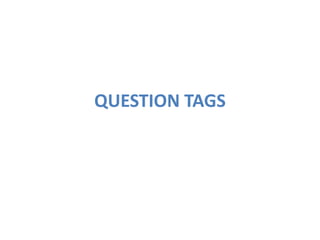Question tags ppt
- 2. QUESTION TAGSWHAT IS A QT AND WHAT IS IT USED FOR?A questiontagis a short question at theend of a sentenceusingthefollowingform: (SENTENCE) , auxiliaryverb + Subject?We use a questiontag:
- 3. Toasksomeonetoagreewithus. Intonationgoingdowne.g. Todayitâsextremelyhot, isnâtit?Tocheckifsomethingis true. Intonationgoing up e.g. YouâreDanâssister, arenâtyou?
- 4. QUESTION TAGSHOW DO WE FORM A QT?Auxiliaryverb: Ifthemainverb in thesentenceisnegative, toformthetagwe use thecorrespondingaffirmativeauxiliaryverb, and theotherway round.e.g. Theydidnâtagreewithus, didthey?e.g. Sueis living in Paris rightnow, isnâtshe?Subject:Thesubjectused in the QT isthesamethatwehave in thesentence, but in thepronounform. e.g. Lorna and Mattare happytogether, arenâtthey?
- 5. QUESTION TAGSSOME EXCEPTIONSLetâsâĶâĶ, shallwe?e.g. Letâssunbathetoday, shallwe?IâmâĶâĶ., arenât I?e.g. Iâmgetting red, arenât I?ImperativeâĶâĶ.., will/would/couldyou?e.g. Pass me thesalt, willyou?Negativewords(no, never, hardly, nobody, littleâĶ) stand fornegativeverb, so weneed a positive tag. e.g. He never comes, does he?e.g. Thereis no reasonforleavingnow, isthere?There âĶ..., âĶâĶ. there?e.g. Thereis a lot of homeworktoday, isnâtthere?Indefinitepronouns as subjects(someone, everybody, anybody, nobodyâĶ) are substitutedby âtheyâ in the QT. e.g. Someonewill come, wonâtthey?Nothing and everythingare substitutedbyâitâ in the QT. e.g. Everythingis OK, isnâtit?After principal verb âhaveâ, QTs with âhaveâ and âdoâ are often both possible. Note that âdoâ is more common in American English. e.g. They have a farm house, havenât / donât they?




